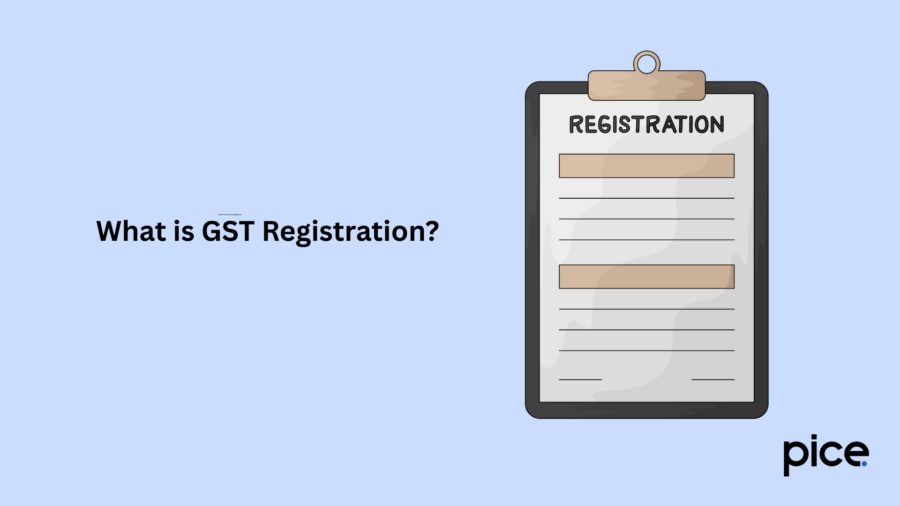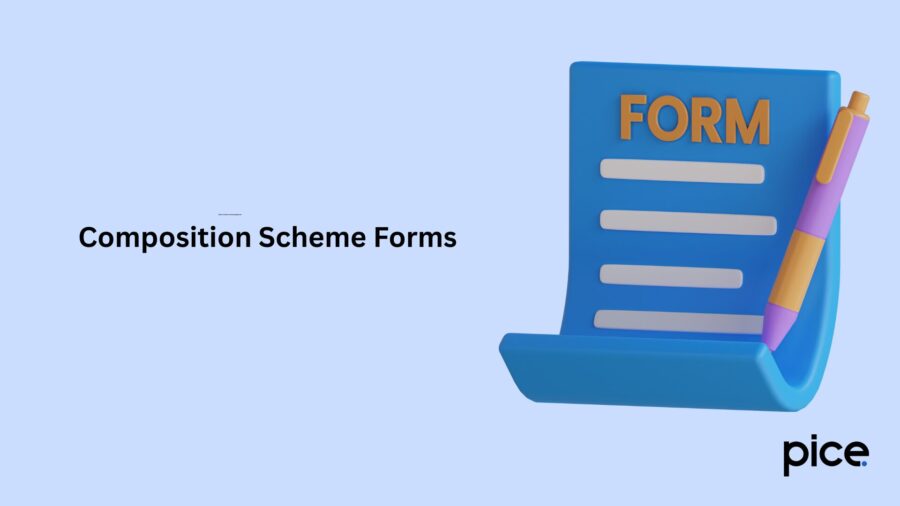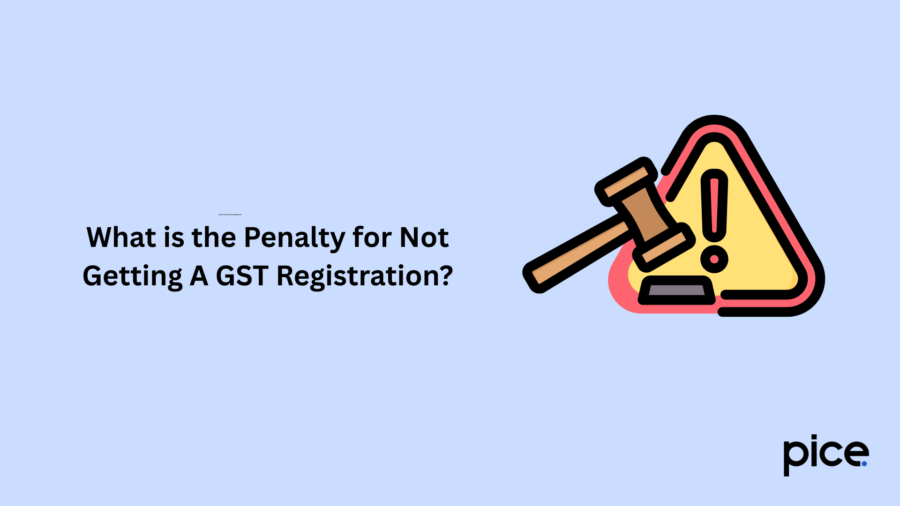Everything You Need Know About GST Registration Forms
- 12 Jun 25
- 14 mins

Everything You Need Know About GST Registration Forms
Key Takeaways
- GST registration is mandatory for businesses crossing the prescribed turnover thresholds, ensuring legal operations and input tax credit eligibility.
- A GSTIN (15-digit unique number) is issued post-registration, vital for invoicing and tax compliance.
- Multiple GST forms serve distinct functions—from registration to cancellation, refunds, audits, and compliance.
- Form GST REG-06 is the official GST Registration Certificate, downloadable via the GST portal.
- Failure to register for GST can result in severe penalties, including fines and legal consequences.
GST registration is one of the preliminary procedures when you start a business to make its operations smoother. It's that entry point to being a legitimate entity in the business world. In India, there are particular turnover parameters, crossing which a GST registration is a must for the businesses. The forms of GST registration represent the basic documentary requirements that are kept handy by the businesses themselves to jump into the formal economy and stay under tax compliance.
Properly entering specific details in the forms brings about advantageous facilities such as tax credit, smooth Interstate business and build a more formal image. Let us now be introduced to a little bit about these forms and understand why these are so important for your business.
What is GST Registration?

GST registration is a course through which a business gets a Goods and Service Tax Identification Number (GSTIN) from the tax authorities in India. It is mandatory for businesses whose gross turnover exceeds a threshold limit-specific limit (currently ₹40 lakhs in case of goods and ₹20 lakhs in a case of services, with some exceptions).
The business can collect GST legally on sales and claim input tax credit on purchases that will help must ease tax flow benefits and cross border regretted taxes.
What is a GSTIN?
Only businesses operating in a particular state or territory are granted the 15-digit Goods and Services Tax identification number, or GSTIN. A taxpayer will receive a GSTIN to use on their tax returns and invoices following GST registration.
The business is assigned a unique GSTIN following the review and approval of the GST registration application by the GST officer. In order to confirm the authenticity of the seller and the GST number or GSTIN listed on the invoice, every business that is subject to GST must disclose the GSTIN.
Who Should Get A GST Registration?
Under the Goods and Services Tax, companies that make more than Rs. 40 lakhs, Rs. 20 lakhs, or Rs. 10 lakhs, as applicable, are required to register as regular taxable persons. According to CGST Section 10 of the Composition Plan, the threshold turnover limit for a select group of professionals and small enterprises is Rs. 50 lakh and Rs. 1.5 crore, respectively.
Some firms must register their operations under the GST statute regardless of their turnover.
What are the Documents Needed for GST Registration?
The following is a list of documents required for GST registration:
- The Applicant's PAN Card
- The Applicant's Aadhaar Card
- Proof of Incorporation or Business Registration
- Photographs verifying the Promoters' or Director's Identity and Address
- Address Proof of the Business's Location
- Cancelled Cheque or Bank Account Statement
- Digital Signature
- Letter of Authorisation from Authorised Signatory
What is a GST Registration Certificate?

A GST Registration Certificate, in Form GST REG-06, is an official document issued to businesses registered under the Goods and Services Tax (GST) regime in India. This certificate serves as a proof of registration and contains essential details such as the business's Goods and Services Tax Identification Number (GSTIN), legal and trade names, principal place of business address, and the type of registration.
It is a crucial document that validates a business as a registered taxpayer, enabling them to collect GST, claim input tax credits, and conduct business legally. The certificate is digitally available on the GST portal.
What are the Types of GST forms?
GST forms under the Goods and Services Tax (GST) regime are structured into various categories, each serving a specific purpose to streamline tax compliance and administrative processes. These categories ensure that different taxpayer needs, such as registration, refund claims, tax deductions, appeals, audits, and transitional matters, are effectively addressed. The GST system includes the following key types of forms:
- GST Registration Forms
GST Registration Forms are the foundation of compliance under GST. These forms facilitate application, amendment, cancellation, and reactivation of GST registration for different types of taxpayers, such as regular, casual, non-resident, and e-commerce operators. There are 31 different forms under this category:
- GST REG-01: Application form for new GST registration by normal, casual / non-resident taxable person . It requires PAN, Aadhaar, and business details.
- GST REG-02: Issued as an acknowledgment of the application filed under REG-01 along with an Application Reference Number (ARN).
- GST REG-03: Used by the GST officer to request additional documents, clarifications, or amendments during the registration process.
- GST REG-04: Response form for providing clarification or documents requested in REG-03.
- GST REG-05: Order for rejection of refund claim, registration, amendment, or rejection of application, with reasons clearly mentioned.
- GST REG-06: Final GST Registration Certificate issued upon successful approval of the application. It includes the GSTIN and other registration details.
- GST REG-07: Application for registration as a Tax Deductor or Tax Collector under GST, primarily used by government departments and notified entities.
- GST REG-08: Used for cancellation of TDS/TCS registration when the deductor or collector no longer qualifies.
- GST REG-09: Mandatory for non-resident taxable persons conducting business in India. It includes passport and business details.
- GST REG-10: Application for registration by the OIDAR or Online Information and Database access or Retrieval service of providers of foreign countries supplying to Indian consumers.
- GST REG-11: Filed by casual or non-resident taxable persons requesting an extension of the registration validity period.
- GST REG-12: REG-12 Order granting temporary registration, including Suo Moto registration initiated by tax authorities.
- GST REG-13: Filed by embassies, UN bodies, and similar entities to obtain a Unique Identity Number (UIN) for GST refund purposes.
- GST REG-14: Used to apply for changes in existing registration, such as business name, address, or constitution.
- GST REG-15: Order of amendment issued by the department after verifying the REG-14 registration application.
- GST REG-16: Application for cancellation of voluntary registration filed by a taxpayer.
- GST REG-17: Show Cause Notice for proposed cancellation of registration due to default or non-compliance.
- GST REG-18: Reply to the Show Cause Notice issued in REG-17, where the taxpayer provides justifications.
- GST REG-19: Final order cancelling the GST registration, with details of effective cancellation date.
- GST REG-20: Order for dropping cancellation proceedings when the explanation provided in REG-18 is satisfactory.
- GST REG-21: If you face rejection of application and you want to revoke GST registration, this form needs to be submitted within 30 days of cancellation.
- GST REG-22: Order restoring GST registration when revocation is approved.
- GST REG-23: Show Cause Notice for rejection of revocation application, if the officer finds discrepancies.
- GST REG-24: Reply to REG-23 notice, justifying the request for the application for revocation.
- GST REG-25: Provisional Registration Certificate granted during migration from the pre-GST era.
- GST REG-26: Used by existing taxpayers to complete application for enrollment and verify the provisional details.
- GST REG-27: Show Cause Notice issued for cancellation of provisional registration due to incomplete migration.
- GST REG-28: Order confirming the cancellation of provisional registration.
- GST REG-29: Application by taxpayer to cancel provisional registration voluntarily.
- GST REG-30: Field Visit Report prepared by tax officers during physical verification of premises.
- GST REG-31: Intimation of details regarding suspension of GST registration and notice for cancellation.
- Composition Scheme Forms

Small businesses looking to ease their tax burden can opt for the Composition Scheme under GST, which allows for simplified returns and lower tax rates. The Composition Scheme forms are used to apply for, manage, or withdraw from this scheme.
These forms allow taxpayers to:
- Apply for entry into the scheme.
- File quarterly returns using simplified formats.
- Notify authorities in case of turnover exceeding the scheme threshold or voluntary withdrawal.
This category significantly reduces the tax compliance burden on micro, small, and medium enterprises.
- Section 35 Enrolment Forms
Under Section 35 of the CGST Act, specific entities such as warehouse operators or transporters must maintain accounts and records as prescribed. Section 35 enrolment forms are used by these parties to register their business and comply with documentation norms.
These forms primarily help the government track the movement and storage of goods across the country and prevent tax evasion.
- Refund Forms
Refund forms are vital for claiming excess tax paid, refunds on exports, inverted duty structures, or when input tax credit exceeds output liability. The form for application for refund must be filed along with supporting documents and explanations.
- Refund forms include fields for refund calculation, bank details, personal details and justification for the claim.
- They play a crucial role in maintaining liquidity for businesses, especially exporters and inverted duty structure taxpayers.
- Input Tax Credit (ITC) Forms
Input Tax Credit (ITC) is one of the central mechanisms of GST that avoids tax-on-tax and helps businesses reduce their final tax outgo. ITC Forms allow different type of taxpayer to:
- Claim credit for GST paid on purchases.
- Reverse ITC when conditions are not met.
- Match and reconcile input and output data.
These forms are key to reducing the effective cost of goods and services for compliant businesses. Errors in ITC claims can lead to interest and penalties, making these forms crucial in daily GST operations.
- Audit Forms
Large businesses crossing a turnover threshold are subject to GST audits. Audit forms are used by both the taxpayer and the department to:
- Furnish audit details.
- Submit reconciliation statements.
- Provide detailed financial disclosures.
These forms ensure that the taxpayer’s books align with GST returns, and they help the authorities detect under-reporting or incorrect tax filings.
- Electronic Ledgers Forms
GST portal operates on a fully digital platform, and Electronic Ledgers Forms are used to maintain:
- Cash Ledger (for payments made).
- Credit Ledger (for ITC available).
- Liability Ledger (for tax liabilities).
These forms are automatically updated and ensure transparency between the taxpayer and the department. Reviewing these ledgers helps businesses track due payments, claim credits correctly, and maintain proper compliance.
- Appellate Authority for Advance Ruling Forms

If a taxpayer disagrees with a ruling provided by the Advance Ruling Authority, they can appeal to the Appellate Authority. These forms allow the taxpayer or the tax department to:
- File an appeal.
- Submit supporting evidence.
- Present their interpretation of the law.
It helps resolve disputes before they escalate into litigation and gives taxpayers confidence in their GST treatment of specific transactions.
- Advance Ruling Forms
Taxpayers who want clarity about how GST applies to a specific transaction or future activity can seek an Advance Ruling. These forms help in:
- Filing applications for rulings.
- Seeking interpretation on classification, rate, and applicability.
This is especially useful for new or complex business models and helps avoid costly litigation or retrospective penalties.
- E-Way Bill Forms
An essential compliance mechanism under GST is the E-Way Bill, used for tracking the movement of goods of e-commerce platforms worth more than a threshold value. The E-Way Bill forms are used to:
- Generate e-way bills.
- Update transportation details.
- Cancel or extend validity of e-way bills.
They ensure transparency in goods movement and help prevent tax leakage across state borders.
- Transitional Credit Forms
When India moved from the old indirect tax regime to GST, businesses were allowed to carry forward eligible tax credits. Transitional Credit Forms were used to:
- Declare closing balances of VAT, service tax, and excise.
- Claim credit in the GST regime.
Though transitional forms were primarily used during the initial phase of GST rollout, they remain important for audits and legacy cases.
- Inspection Forms
To enforce compliance, the GST department has been empowered to conduct inspections, searches, and seizures. Inspection Forms are used to:
- Record inspection details.Notify taxpayers about searches or seizures.Maintain legal validity of actions taken during enforcement.
These forms are crucial for transparency and safeguarding taxpayer rights during enforcement actions.
- E-Invoicing Forms
E-Invoicing under GST mandates that B2B invoices be uploaded to the Invoice Registration Portal (IRP) to receive a unique Invoice Reference Number (IRN). The E-Invoicing Forms facilitate:
- Standardised invoice generation.
- Real-time validation.
- Auto-population of returns.
This mechanism prevents fake invoicing and allows seamless integration between tax systems and ERP platforms.
Each of these GST form categories supports different business and administrative functions. Whether it’s a small business opting for composition, a non-resident registering temporarily, or an exporter filing for a refund, the relevant GST forms are central to fulfilling obligations and availing lawful benefits under the GST regime.
What is the Penalty for Not Getting A GST Registration?

Every business within India that surpasses the GST threshold (₹40 Lakh for goods, ₹20 Lakh in services, or ₹10 Lakh for certain special category states) must register for GST. Penalty for non-registration amounts to ₹10,000 or 10% of the tax dues, whichever may be higher.
However, in cases of intentional tax evasion, the penalty may be as high as 100% of tax dues. Besides being unable to claim input tax credit, non-registration would lead to business stagnation and the possibility of legal consequences.
Conclusion
Knowing each of the GST registration forms enables taxpayers to meet their obligations efficiently while ensuring smooth business management. Companies that register themselves under GST gain better credibility among customers and can, as a result, claim input tax credits.
In addition to GST registration, businesses must complete multiple forms in the GST framework to handle compliance requirements, including refunds, audits, claims of input tax credit, e-invoicing, advance rulings, etc.
💡If you want to streamline your invoices and make payments via credit or debit card or UPI, consider using the PICE App. Explore the PICE App today and take your business to new heights.
 By
By 

















